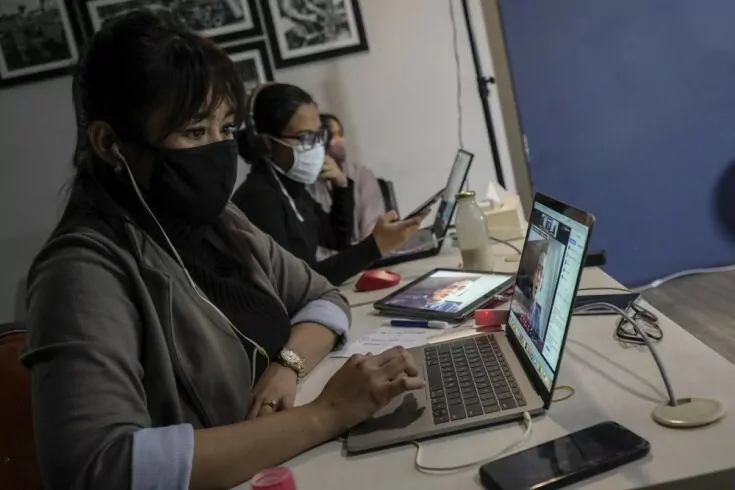By Magdalena Skrzypek, Impact and Communications Manager.
In our 25-year history we have worked with clients to navigate challenges including wars, the emergence of autocrats, hyper-inflation and the global financial crisis. When the Covid-19 pandemic hit, bringing with it unprecedented challenges for media worldwide, we drew on all these experiences to help clients navigate the profound disruption that struck their operations, from newsgathering to revenue generation. We shared our recommendations on practical steps media can take to weather the storm and position themselves to emerge strongly for the future – available here and here in a dozen languages.
The pandemic has made it clear that the media’s need for financial resilience is greater than ever, with the viability of even the best-positioned media under strain. Yet if we look for positives, the crisis also presents an opportunity for the industry: a chance to transform, embrace new ways of working and come out stronger on the other side. For example, in 2020 we saw online audiences of our clients grow dramatically, with nearly eight times more people receiving news from MDIF-supported media online (233 million) than through traditional means (29 million). How can media capitalise on this surge in demand?
Here we reflect on what Covid-19 has taught us about responding to crisis. We present some of the findings of our annual Impact Dashboard survey and look at how the pandemic affected our clients’ reach, revenues, and viability (the full Impact Dashboard will be published later this year), alongside other global surveys on the implications of the coronavirus on journalism. While each situation is unique, we believe the experience of our portfolio offers useful insights into the impact of the pandemic on the media industry in emerging markets.
How the pandemic affected our clients
The impact of the pandemic and the infodemic, alongside the daily stress of living and working with the virus, are an ongoing challenge for media businesses and workers worldwide. Its economic consequences have exacerbated challenges facing media all over the world – from bringing to light unsustainable cost bases to accelerating decline in print circulations due to lockdown restrictions.
It is a testament to our clients’ hard work, flexibility and resilience (and to our great relief) that all but one media company we work with managed to make it through the year – and the reason that client closed its operations was not related to Covid-19.
Nine out of ten media report negative impact on business
Our annual questionnaire, which surveys our active media clients, showed that for a large majority of respondents – 88% – Covid-19 had a negative impact on their business, ranging from huge (35%), moderate (41%) to small negative impact (12%). Only 3% said that the pandemic had no impact on their business, while 9% said that the impact was positive.
Perception of Covid-19 impact
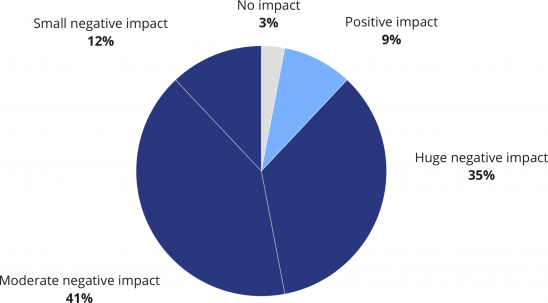
Economic impact presents biggest challenge
The biggest challenge for media was by far the economic impact and decline in revenues, with 70% of respondents rating it as 4 or higher, where 5 represents the biggest challenge and 1 represents the smallest challenge, with an average rate of 4.1. In comparison, the second most-rated were changes in newsgathering practices as well as the physical and mental health and safety of the workforce (both rated 2.9).
Perception of challenges amid Covid-19
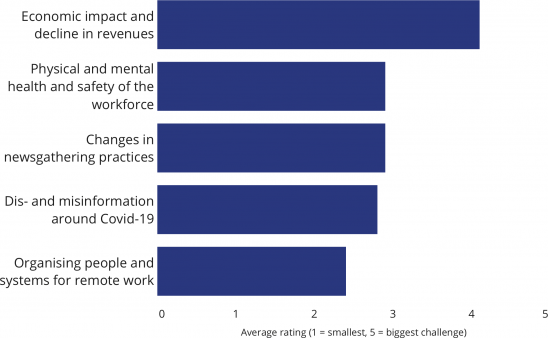
Revenues dip during pandemic
The overall picture painted by our longitudinal measurement of clients’ revenues carried out as a part of annual Impact Dashboard clearly indicates that the pandemic had a major impact on their businesses. When the virus forced newsrooms to close their doors and make changes to their newsgathering practices, it also slashed their revenues. Among MDIF clients active in both 2019 and 2020, over half saw their revenues decrease from year to year (53%), with falls ranging from -1% to -68%. The remaining 47% increased or maintained their revenues, with one client managing to double their revenues between 2019 and 2020. The average change between the two years stood at 1% (a median of -4%). These results are in line with a global survey by the Reuters Institute for the Study of Journalism, which found that more than a third of survey respondents reported a fall in revenue of 30% or more.
Clients’ viability worsened
Unsurprisingly, clients’ viability also worsened during the pandemic. According to the risk-rating we use to monitor the financial viability of individual media organisations, at the end of 2020, the number of high-risk loan clients (the risk-rating tool we use is not applicable to equity clients) increased from 20% in 2019 to 37% in 2020. Among clients active in both 2019 and 2020, 13% maintained their risk rating from year to year, while 87% saw their risk level rise. Between 2019 and 2020, the median risk rating of our loan clients increased from 5.75 to 6.45, a historically high level, though still within the moderate risk range on the nine-point scale (a risk rating of seven or above is considered high risk, between seven and five is moderate risk and below five is low risk).
Demand for high-quality media rises
As a counter-trend, audiences for high quality media rose dramatically, with record-breaking numbers of people seeking reliable news and information about the pandemic. MDIF clients experienced their peak audiences in mid-March at a time when the World Health Organization declared Covid-19 a pandemic, reaching as many as 312 million people that month. On an individual level, clients active in both 2019 and 2020 increased their reach by 42% on average between the two years. In fact, 90% of MDIF-supported media increased (84%) or maintained (6%) their reach, while 13% doubled their audience between 2019 and 2020.
Total client reach throughout 2020
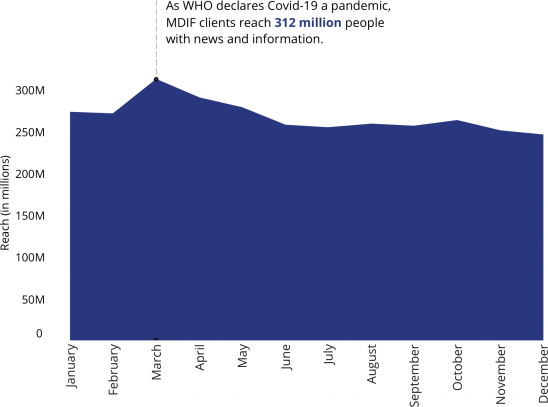
Media find benefits from home-working and new revenue sources
To limit the adverse impact on their businesses, MDIF clients had to be agile in their response to rapidly changing circumstances. When, as part of the Impact Dashboard survey, presented with a list of 17 different measures and asked to indicate those they introduced to tackle the crisis, 70% identified five measures or more, while 23% selected 10 or more. Working from home (87%), reduced expenses for travel and on-the-ground reporting (77%) and suspended planned salary increases (60%) were the three most common measures taken.
When asked which out of all measures introduced had the greatest positive impact, the respondents selected working from home and the introduction of new/alternative revenue sources (each 23%). Laying off or furloughing staff was the second least frequent measure taken.
Measures introduced to tackle the crisis
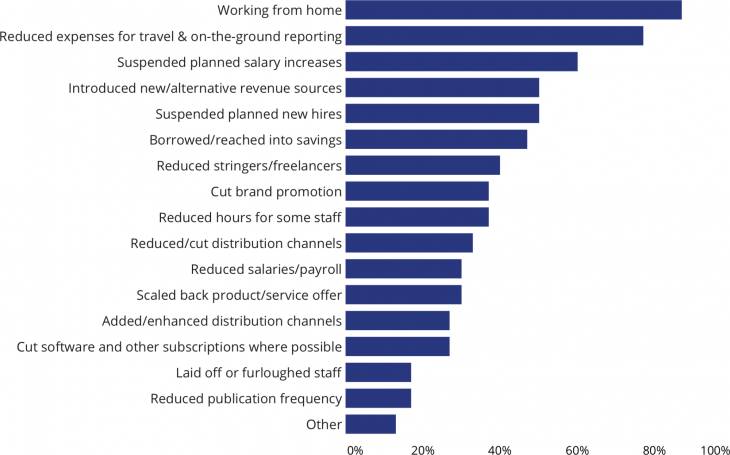
The ongoing importance of financing and technical assistance
The crisis showed that the need for media financing is stronger than ever, with independent news organisations identifying funding as the most critical need in multiple global surveys on the implications of the coronavirus on journalism. A study by the International Center for Journalists (ICFJ) and the Tow Center for Digital Journalism at Columbia University identified funding as media’s greatest need. In the survey of more than 1,400 journalists from 125 countries, 76% rated funding to cover operating costs (including salaries) as important or very important due to the crisis. Similarly, a report by the Reuters Institute for the Study of Journalism found that more than 80% of media respondents said that their most critical need was funding.
These findings highlight the global shortage of funding, including a lack of affordable financing, and validate our mission to provide loans and equity investments to independent media to strengthen their viability. Staying true to this mission and in keeping with our track record spanning 25 years, in 2020 we completed 18 investments in 16 media companies in 13 countries, totalling $5.7 million.
While providing patient capital has always been a cornerstone of our investment strategy, the importance of this approach has been highlighted during the crisis. From our experience of the 2008 financial crisis, we knew that it can take time and up-front costs to right-size companies and help put them in a position where they can survive. So, as an immediate step to ease the economic blow from Covid-19, we gave a six-month interest-free loan payment holiday to all our borrowers in good standing.
In addition to providing much-needed financing and payment holidays, our Media Advisory Services (MAS) also offered business crisis assistance. In 2020, MAS reached as many as 384 media companies, including MDIF clients but also non-clients, with practical management advice and assistance for surviving the pandemic’s impact.
And while there is no silver bullet to overcome the effects of the crisis and successful news companies do plenty of things differently, depending on their unique goals, challenges and processes, there are some steps that apply equally to most media organisations, such as cost-optimisation, seeking new revenue generation opportunities and deeper audience understanding and engagement.
To support our clients and media more widely, we published recommendations for media, based on our experiences of tackling crises and the lessons learned by our clients as they responded to the pandemic, in a dozen languages at the beginning and end of 2020.
Optimism in a time of uncertainty
Within the dark reality of the pandemic, there are glimmers of hope and possibilities for a way forward for media.
In 2020, financial resilience and business viability, MDIF’s area of work for the past 25 years, were buzzwords mentioned in almost every media development conversation. Strong financial foundations and sound processes around planning and budgeting proved to be necessary to sustain media business in this turbulent environment. The emergency forced media companies to clarify their value proposition, deal with unsustainable cost bases and identify inefficient operations, from strategy and development to workflows and products.
It also showed the importance of experimenting with alternative revenues and proved that most sustainable news organisations need to have several sources of income. According to our annual Impact Dashboard survey, when asked about their main sources of revenue (10% or more of income), 71% of clients reported that they had at least three sources of income and 35% identified at least four.
The crisis also accelerated changes in global media consumption habits and adoption of digital technologies. While many of our clients have an enviable level of digital maturity, others not so much, whether due to complexity, cost, the potential disruption to operations or simply lack of buy-in within the organisation. In the new reality, with millions of people retreating to the safety of the online world, the imperative of digital transformation moved from important to absolutely critical. As a measure – and as noted above – in 2020 nearly eight times more people received news from our clients online (233 million) than through traditional means (29 million).
In a time of great uncertainty, understanding audience also proved to be elemental. In 2020, we saw more media companies develop audience-centric solutions that strengthen engagement, build affinity and form relationships with the communities they serve, and use data analytics to better understand their behaviours and attitudes. Many publishers turned to subscription, membership and donations to make up for lost advertising and diversify their revenue mix. The most common source of income after advertising (selected by 76% of clients) was reader revenue (38%), according to our survey.
Yet, most importantly, the pandemic underscored the value of independent media. For example, trust in news media increased from 38% to 44% over the past year, according to the annual Reuters Digital News Report. At a time when lives are at stake, media have played an crucial role, tirelessly bringing news updates and providing checks and balances to governments’ responses on behalf of citizens.
In 2020, 95% of MDIF-supported media declared that they had carried out work around Covid-19 that had an impact on their communities. This vital work further underlines their essential role in society and demonstrates once again that they – in keeping with our mission statement – are key in providing the news, information and debate that people need to build free, thriving societies.
These are and will continue to be challenging times, but the resilience, resourcefulness and innovation our clients have shown in serving their audiences and creating robust businesses in the face of adversity fills us with optimism.
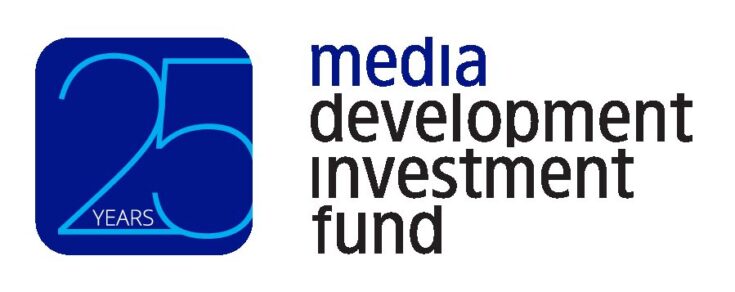
This article is part of our series, ‘25 things we’ve learned’, marking MDIF’s 25th anniversary.
